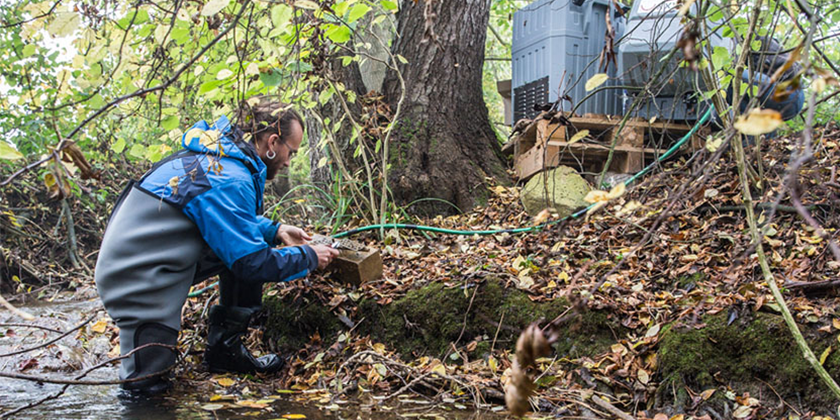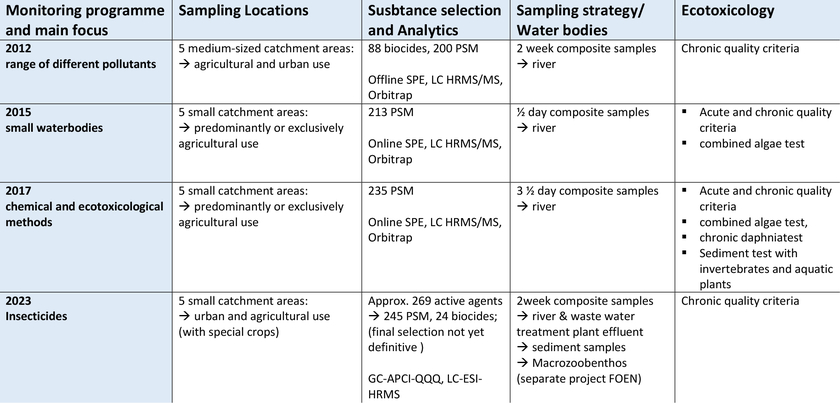NAWA SPEZ
Investigations into pesticide contamination in surface waters

Pollution of our waters with organic micropollutants represents a challenge for water protection. The Federal Office for the Environment (FOEN) and the cantons have, together with the National Surface Water Quality Monitoring (NAWA), established a measurement programme to assess the status and development of pollution of Swiss surface waters. Special investigations are carried out on various aspects as part of this measurement programme. In 2012, 2015 and 2017, the type and extent of water pollution with biocides and plant protection products (PPPs) were investigated and assessed in three measurement campaigns.
Recent national and international studies have shown that in particular, pyrethroid and organophosphate insecticides, which are toxic to aquatic organisms, can have a negative impact on water quality, even at very low concentrations. For this reason, the federal government and the cantons have intensified measurements of these insecticides in Swiss waters in recent years. However, it is not yet fully understood to what extent other insecticides, and other active substances that have yet to be investigated in detail, occur in Swiss watercourses. In addition, it is not yet clear whether treated wastewater is a significant input pathway for these substances into water bodies. For this reason, a specific large-scale study will be carried out in 2023 at five locations in Switzerland (see overview map) to investigate as completely as possible a range of PPPs and biocides in agricultural and residential catchments for the duration of the project. In addition to the measurements in the watercourse, measurements will also be taken from treated wastewater of sewage treatment plants that discharge their wastewater into the watercourses of interest.
Locations NAWA Spez23
Map: Bundesamt für Landestopographie
catchment areas: BAFU 2019: Teileinzugsgebiete 2 km2
land use information: BAFU 2013: Gewässerabschnittsbasierte Einzugsgebietsgliederung der Schweiz
(GAB-EZGG-CH)
waste water treatment plan information: Kennzahlenerhebung Abwasserreinigung des Bundes, 2021
The goals of the NAWA Special Campaign 2023 are:
- To determine as comprehensively as possible the pollution of small to medium-sized watercourses with plant protection products (PPPs) and biocides, especially insecticides
- To investigate treated wastewater, in addition to diffuse inputs from agricultural land, as a possible input pathway for PPPs and biocides.
Together, these aims will provide information on the use of PPPs and biocides in agriculture and settlements. In particular, the focus on insecticidal active substances is intended to close observation gaps in the area of particularly toxic substances. To achieve this, firstly, complete sampling of the selected watercourses and sewage treatment plants will be carried out over the entire application period using two-week composite samples. Secondly, the latest trace analytical detection methods will be used for sensitive and comprehensive detection. The analytical methods used allow quantification in the low pg/L concentration range, and thus also enable detection of active substances that have a toxic effect on aquatic organisms, even at very low concentrations.
The following table summarises the focal points of all NAWA special studies carried out to date in the field of PPPs and biocides. The studies were conducted in close cooperation between Eawag, the cantons (via Cantonal Water Protection Agencies), the VSA, the Ecotox Centre and the FOEN, and are unique in their scope and depth. The assessment of the measurement results was carried out in each case on the basis of the valid legal requirements and ecotoxicologically derived quality criteria (QC).
NAWA SPEZ 2017: Small watercourses – chemical and ecotoxicological methods

The focus of the NAWA SPEZ survey is once again on pollution from plant protection agents in small watercourses in areas with heavy agricultural use. Two out of the five areas are being surveyed for a second time, which will allow the researchers to make comparisons between the two survey years — something which has not been done previously. Experience gained through the previous two studies led the researchers to extend the 2017 monitoring period by two months, with measurements being taken between the beginning of March and the end of October. Three half-day mixed samples were taken and analysed for PPPs. The emphasis of NAWA SPEZ 2017 is being placed on the employment of further, supplementary chemical and biological methods.
NAWA SPEZ 2015: Small watercourses – an overview of pesticide contamination

An initial evaluation of data collected in Switzerland on pesticide load revealed that only 20% of the data came from small watercourses, even though these make up 75% of the total distance covered by Switzerland’s network of watercourses (Munz et al. 2012). Moreover, the monitoring programmes were often temporally limited, or restricted to random sampling. The aim of the second NAWA SPEZ study was therefore to close these gaps.
Five small watercourses in areas with heavy agricultural use were screened for 213 active PPP substances. The work was carried out with a variable temporal resolution, whereby half-day mixed samples were taken during rainfall events, and longer mixed samples (from 24 hours to a maximum of 24 days) were taken during dry periods. The analytics employed enabled 70% of the PPPs permitted in 2015 to be measured. Also measured were numerous PPPs which were no longer permitted, but which were still found to be present in the environment because of their slow degradation times.
Altogether 128 PPPs were found to be present. Chronic quality criteria were exceeded in all of the catchment areas, and in four of the catchment areas acute quality criteria were also exceeded. The comparison with NAWA SPEZ 2012 showed that the peaks in contaminants in small watercourses are short-lived, but concentrations are, on the other hand, higher. A significant proportion of the instances of acute quality criteria being exceeded are attributable to this effect.
The catchment areas surveyed were all subject to a comparable level of agricultural use. Estimates indicated that although pollution levels may be lower in areas that are less heavily used for agricultural purposes, effects on sensitive aquatic organisms could not be ruled out in these areas. In terms of recommendations for routine monitoring going forward, it was shown that it is also possible to gather a substantial amount of pollution data with a reduced amount of effort: so, for the 41 PPP substances that were proposed in the Assessment Strategy for diffuse inputs, 72% of the chronic quality criteria, and 87% of the acute quality criteria were found to have been exceeded as a result of PPP inputs. It is important that measurements are taken over a sufficiently long period, as in some of the catchment areas the concentration levels were found to be increasing even at the end of the monitoring period.
Publications
NAWA SPEZ 2012: Medium-sized watercourses – overview of pesticide load

The aim of the first NAWA SPEZ study was to gain a thorough understanding of which particular substances were contributing the most to pollutant loads. Five medium-sized watercourses were screened for biocides and PPPs using two-week mixed samples. The comprehensive analytics employed enabled the researchers to measure 81% of all polar organic and synthetic biocides and 91% of all polar organic and synthetic PPPs.
Altogether 104 pesticides were identified as being present, of which 82 substances were purely PPPs, 20 were substances permitted for dual use (as PPPs as well as biocide) and two were purely biocides. Chronic quality criteria were exceeded in all of the catchment areas. The results of the study underline the prominence of PPPs in the material pollution of surface waters. The information thereby gleaned formed a core part of the Assessment Strategy for Micropollutants developed by Eawag and the Centre for Ecotoxicology, which determined the list of substances to be prioritised for evaluation within the routine monitoring programme.







